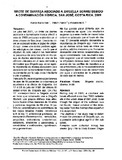Mostrar el registro sencillo del ítem
Brote de diarrea asociado a Shigella sonnei debido a contaminación hídrica, San José, Costa Rica, 2001
| dc.creator | Barrantes Jiménez, Kenia | |
| dc.creator | Pardo, Vekoh | |
| dc.creator | Achí Araya, María Rosario | |
| dc.date.accessioned | 2015-01-16T21:39:55Z | |
| dc.date.available | 2015-01-16T21:39:55Z | |
| dc.date.issued | 2004-01 | |
| dc.identifier.ismn | 0253-2948 | |
| dc.identifier.uri | https://hdl.handle.net/10669/11269 | |
| dc.description | artículo arbitrado -- Universidad de Costa Rica, Instituto de investigaciones en Salud. 2004. | es_ES |
| dc.description.abstract | En julio del 2001, un brote de diarrea asociado a transmisión hidrica afecto a mas de 7000 personas residentes en el área urbana de San Jose. Desde su inicio se especulo sobre el papel de Shige- Ila spp., como uno de los posibles agentes etiologicos del mismo, por lo que el objetivo de este estudio fue determinar la presencia de esta bacteria en los cases de diarrea atendidos en una de las clinicas ubicadas en el area del brote y demostrar que Shigella spp. es un agente importante de diarrea en nuestro pais asociado con la transmision hidrica, particularmente por la baja dosis infectante y alta virulencia. Para este fin, se analizaron especimenes fecales de 49 pacientes con diarrea que acudieron a la clinica de Alajuelita, del 17 al 31 de julio del 2001. Se obtuvo 16 aislamientos de Shigella spp. (34,7%), 15 correspondieron a Shigella sonnei en tanto que solamente uno a Shigella flexneri. Los grupos etareos mas afectados fueron niños menores de 10 anos y personas mayores de 60 afios. El patron de sensibilidad a los antibioticos de las cepas aisladas mostro resistencia a 8 de los 11 antibioticos probados: trimetoprim/ sulfametoxazole, tetraciclina, ampicilina, eritromicina, cloranfenicol, cefalotina, amikacina y amoxicilina; y sensibilidad a norfloxacina, ciprofloxacina y gentamicina.No fue posible aislar Shigella spp. de las muestras de agua. Los resultados sugieren que este medio de transmisión estuvo relacionado con el brote de diarrea. El presente estudio demuestra Ia importancia de Shigella spp. como causa de diarrea sobre todo en niños pequeños, adultos mayores y su frecuente asociacion con brotes relacionados con agua contaminada. Los resultados también sugieren que el tratamiento contra Ia shigelosis debería incluir informacion acerca de los perfiles de resistencia a los antibioticos y de Ia necesidad de mas investigacion sobre vias de transmisión por agua y alimentos en la prevención de este tipo de brotes. | es_ES |
| dc.description.abstract | During July of 2001, a diarrhea' outbreak affected more than 7000 individuals in the urban area of San Jose. Even though the origen of the outbreak was not found, faecal pollution of the drinking water from the metropolitan aqueduct it is suspected. The objetive of the study was to determinate the presence of Shigella spp., as a possible aetiological agent of the outbreak. Samples were collected during two weeks (july 17th to 31st) Sixteen Shige-Ila spp. isolates were obtained out of 49 patients with diarrhoea (34,7%), 15 of the isolates were Shigella sonnet and 1 corresponded to Shigella flexneri. The most affected age groups were children under 10 and people older than 60. The antibiotic susceptibility pattern of the Shigella spp. isolates showed that they were resistant to eigth of the antibiotics: trimethoprim/sulfamethoxazole, tetracycline, ampicillin, eritromicine, chloramphenicol, cephalotin, amikacine and amoxicillin. They were sensitive to norfloxacin, ciprofloxacin and gentamicin. Althought it was not possible to isolate Shigella ssp. directly from water, the results highly suggest this pathogen to be the aetiological agent of the outbreak. This study demonstrates the import role of Shigella spp. as cause of diarrhea affecting mainly small children and elderly people and its frequent association to outbreaks related to drinking water. This study also suggests that guidelines for treatment of shigellosis should include information on the antibiotic resistance pattern and further studies regarding the routes of transmission by water and food, will be required for strategies of prevention of such outbreaks. | es_ES |
| dc.description.sponsorship | Universidad de costa Rica, Instituto de investigaciones en Salud. | es_ES |
| dc.language.iso | es | es_ES |
| dc.publisher | Revista Costarricense de Ciencias Médicas 25(1-2), 15-24 | es_ES |
| dc.subject | Shigella sonnei | es_ES |
| dc.subject | Diarrea | es_ES |
| dc.subject | Salud pública | es_ES |
| dc.subject | Contaminación del agua | es_ES |
| dc.title | Brote de diarrea asociado a Shigella sonnei debido a contaminación hídrica, San José, Costa Rica, 2001 | es_ES |
| dc.type | artículo original | |
| dc.description.procedence | UCR::Vicerrectoría de Investigación::Unidades de Investigación::Ciencias de la Salud::Instituto de Investigaciones en Salud (INISA) | es_ES |


